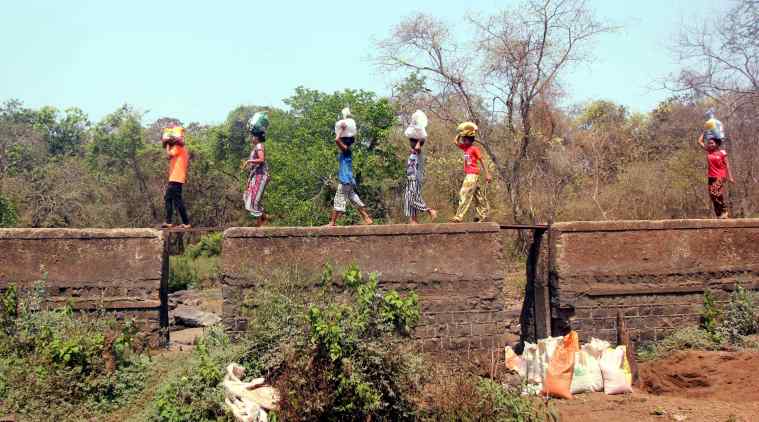 According to the study, 54 per cent of forest land recommended for diversion falls under Moderately Dense Forest and 4 per cent falls under Very Dense Forest. (Representational Image)
According to the study, 54 per cent of forest land recommended for diversion falls under Moderately Dense Forest and 4 per cent falls under Very Dense Forest. (Representational Image)
A survey conducted by an environmental law firm has found a steady decline in recommendations for the diversion of forest land for various projects over the past three years.
Forest land is usually recommended for diversion by state governments for the development of various infrastructure projects or mining, and then given a final approval by the Union Ministry of Environment, Forest and Climate Change (MoEF) after having received clearance from the Ministry’s Forest Advisory Committee or the ten Regional Empowered Committees.
According to the study carried out by the Legal Initiative for Forest and Environment as a part of a series looking at the clearances made by the MoEF, which was released in March, a total of 27,801.07 hectares of forest land was recommended for diversion for non-forestry uses such as mining, roads, railways, hydel, infrastructure etc, between January and December 2017. The area approved dropped to 21,781.30 hectares in 2018 and was as low as 13,656.60 hectares in 2019.
State-wise statistics reveal that out of 24 states that had given recommendations in 2019, 10 states accounted for 82.49% of total forest land recommended for diversion for non-forestry purposes in 2019, amounting to the diversion of 11,265.382 hectares of forest land.
The highest number of proposals came from Odisha (1697.75 hectares), followed by Jharkhand (1647.41 hectares) and Madhya Pradesh (1626.8 hectares). The least amount of forest diversion last year was in Meghalaya, with just over six hectares having been diverted.
IG (Forests) A K Mohanty said, “The number of recommendations has reduced because of ecological concerns. There are a number of filters that a proposal has to go through before a recommendation for forest diversion is given. We look at things like the density of the forest, for instance, and if there can be an alternate site. If indeed the forest diversion is required, we look at mitigation measures.”
But environmental lawyer and Legal Initiative for Forest and Environment (LIFE) founder Ritwick Dutta said while the number of recommendations has indeed reduced, the actual rate of rejection of such proposals is a mere 2.36 per cent. Out of 423 proposals received in 2019 for forest diversion, only 10 were actually rejected, while another 66 were set aside for consideration after more details had been furnished by the user agency.
“Barring Plantation Forests, 58 per cent of forest land recommended for diversion falls under moderately dense and very dense forest which has been a major concern from an environmental angle. One of the reasons why this is done is because human habitation is less if not nil in very dense forest and therefore you don’t have the cost of either rehabilitation, or acquisition of the land. In open forest areas, which are less dense, human populations are more. In most cases we have found that the ministry rarely ever rejects the recommendations… If there are less proposals, we feel that this is because the economy has not been doing well,” Dutta said.
According to the study, 54 per cent of forest land recommended for diversion falls under Moderately Dense Forest and 4 per cent falls under Very Dense Forest. “This implies that nearly 58 per cent of the forest land (barring plantations and data unavailability) recommended for diversion falls under dense forest category i.e. forest land where tree canopy coverage is at least 40 per cent of the total area,” the study said.
The study also pointed out that 45 per cent of the forest land recommended for diversion, that is 6145.47 hectares, falls in wildlife habitats, including wildlife sanctuaries, national parks, conservation reserves and community reserves, eco-sensitive zones of protected areas, tiger reserves, elephant reserves, wildlife corridors and movement paths used by wildlife. The analysis also finds that 16 projects, spread over 691.63 hectares of forest land were recommended in elephant habitat for roads, railways etc.
Out of 13,656.60 hectares of forest land recommended for diversion, 7,064.26 hectares, or 51.73 per cent was for linear projects such as Roads, Railways, Transmission Lines and Pipelines. This is followed by 4,070.89 hectares or 29.81 per cent for mining and quarrying and 1,386.3 hectares or 10.15 per cent for irrigation projects.
For forest land diversion for the construction of roads, Gujarat had the highest number of proposals, followed by Maharashtra, Uttar Pradesh, Uttarakhand and Tripura. For transmission lines, the highest number of proposed diversions was by Jharkhand, followed by Uttarakhand, Madhya Pradesh, Arunachal Pradesh and Tripura.
Jharkhand also has the highest number of forest land diversions for railway line construction, followed by Odisha, Uttar Pradesh, Maharashtra and Madhya Pradesh.
“Diversion, especially in the form of linear intrusions into natural areas such as railways and roads, into forests which support closed canopy leads to fragmentation of otherwise continuous forests. Such fragmentation makes these forests more vulnerable to expansion and intensification of encroachments and diversion pressures. The movement of all animals, and not just elephants, is affected by this fragmentation,” Dutta said.